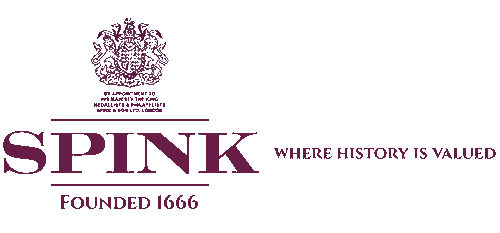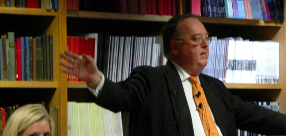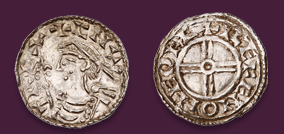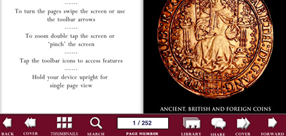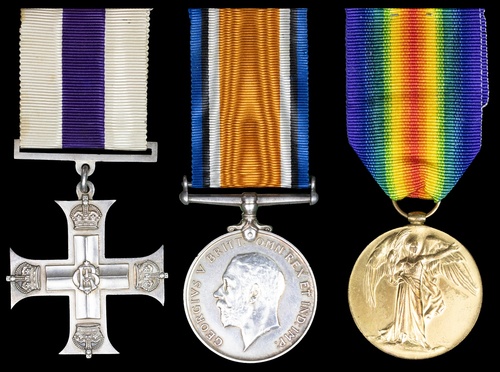
Auction: 25111 - Orders, Decorations and Medals - e-Auction
Lot: 687
A Great War M.C. group of three to Lieutenant D. P. Hadow, Royal Australian Air Force, late Royal Air Force and Northumberland Fusiliers
Military Cross, G.V.R. (Lieut. D. P. Hadow. Northumberland Fus. 1916.); British War and Victory Medals (Lieut. D. P. Hadow. R.A.F.), very fine (3)
M.C. London Gazette 25 November 1916.
'For conspicuous gallantry in action. He led a raid against the enemy with great courage and determination. He set a splendid example to his men.'
Douglas Patrick Hadow was born at St. Chad, Lichfield, Staffordshire on 28 Feb 1898. He was educated at St. Paul's School, London between 1911-13 and served in their O.T.C. for two years. He then studied at Northampton Polytechnic Engineering School between 1913-14 and then served with the University of London O.T.C. for a period of six months during 1915. He was commissioned on 27 April 1916 and made Second Lieutenant with the Northumberland Fusiliers (London Gazette 8 March 1916). He entered the war in France on 16 April 1916 and was awarded his Military Cross for an action at Serre on 14 October 1916.
Serre was a strategic point during the Battle of the Somme, positioned North of Beaumont Hamel it was just a small village and had already defied three murderous assaults by the French in June 1915 and it was known that the Germans had made good use of the landscape and the buildings to turn the area into what they hoped was an impregnable fortress. The German soldiers within the village were from the 169th Regiment (8th Baden) and had been familiarising themselves with the area for well over a year. The French assaults in June 1915 had knocked them off the ridge opposite and given the French (and now the British) their current front line, but the French had paid dearly for their meagre gain.
Hadow transferred to the Royal Flying Corps on 12 March 1917 and entered the war for the second time again in France on 16 July 1917, joining No. 42 Squadron on the 18 July 1917 where he flew as an Observer on RE8 aircraft. Hadow was permitted to wear the Observer's badge from 8 September 1917 and amassed over 108 hours by the end of March 1918. Hadow then went to No. 1 School of Aviation and was permitted to wear his wings on 23 November 1918. He was transferred to No. 61 Squadron and served in Cologne with the R.A.F. Search Unit. Hadow gained an A1 Instuctor's Ticket at the Central Flying School, Upavon and was to be an Instructor at No. 2 F.T.S. at both Digby and Duxford.
However on 31 July 1925 he was arraigned for trial by General Court Martial at Digby, Lincolnshire on the following charges:
'Four charges under Section 16 of the Air Force Act of "behaving in a scandalous manner unbecoming the character of an officer and a gentlemen (sic)", viz. issuing cheques in payment of debts well knowing that he had not sufficient funds at the Bank to meet the cheques.
Four charges (alternative) under Section 40 of the Air Force Act of "conduct to the prejudice of good order and Air Force discipline", viz. issuing cheques in payment of debts having no reasonable grounds for believing that the cheques would be honoured when presented at the Bank.'
He pleaded not guilty to all charges but was found guilty of one of the charges of "behaving in a scandalous manner"; two of the charges of "conduct to the prejudice of good order and Air Force discipline; but not guilty of the remaining five charges; and was sentenced to be cashiered.
The finding and sentence was confirmed by His Majesty The King on the 11 September 1925 who was pleased to commute the sentence of cashiering to one of dismissal.
The sentence was promulgated at Digby, Lincolnshire, on 21 September 1925, and announced in the London Gazette dated 6 October 1925. He was deprived of his rank but was allowed to keep his medals.
Hadow then emigrated to Australia and continued flying becoming an Instructor with the Mount Gambier Aero Club, South Australia, and a Pilot with the Commercial Aviation Company, Eyres Peninsula Airways of South Australia and Goldfields' Air Navigation Company of Kalgoorlie, South Austalia. With the outbreak of the Second World War he enlisted into the Royal Australian Air Force (290355) on 16 October 1939 as a Pilot Officer, becoming a Temporary Flying Officer on 17 December 1939 and acting as a Graded Flying Instructor and was promoted to Temporary Flight Lieutenant on 1 April 1943. He spent his wartime service wholly based in Australia predominantly in Melbourne, however his behaviour with other serving airmen and women was questioned and brought to the attention of the authorities. He was discharged on 4 December 1944 as a result of being permanently medically unfit. Hadow died on 17 August 1948 at Muchea, Chittering Shire, Western Australia and was buried in the Karrakatta Cemetery and Crematorium, Karrakatta, Nedlands City, Western Australia. His service record makes note of being eligible for a 1939-43 ribbon but nothing further is mentioned about claiming medals by him or his next of kin.
Subject to 20% VAT on Buyer’s Premium. For more information please view Terms and Conditions for Buyers.
Sold for
£1,000
Starting price
£480
